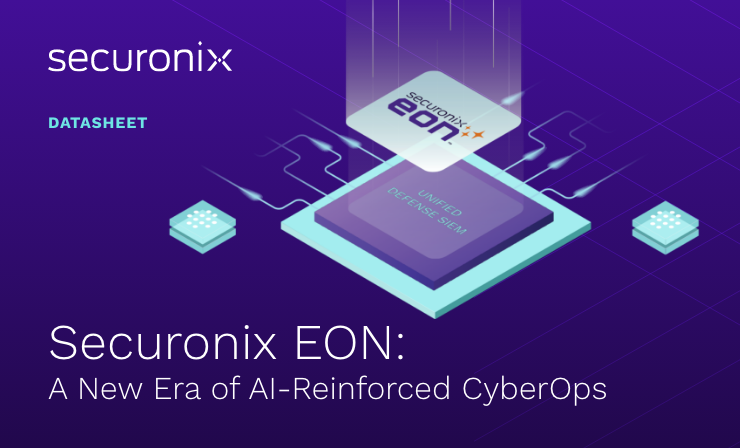- Why Securonix?
- Products
-
- Overview
- 'Bring Your Own' Deployment Models
-
- Products
-
- Solutions
-
- Monitoring the Cloud
- Cloud Security Monitoring
- Gain visibility to detect and respond to cloud threats.
- Amazon Web Services
- Achieve faster response to threats across AWS.
- Google Cloud Platform
- Improve detection and response across GCP.
- Microsoft Azure
- Expand security monitoring across Azure services.
- Microsoft 365
- Benefit from detection and response on Office 365.
-
- Featured Use Case
- Insider Threat
- Monitor and mitigate malicious and negligent users.
- NDR
- Analyze network events to detect and respond to advanced threats.
- EMR Monitoring
- Increase patient data privacy and prevent data snooping.
- MITRE ATT&CK
- Align alerts and analytics to the MITRE ATT&CK framework.
-
- Industries
- Financial Services
- Healthcare
-
- Resources
- Partners
- Company
- Blog
Security Analytics, SIEM
In the face of increasingly evasive cyber threats, traditional security measures are no longer enough to protect your network. Enter Network Detection and Response (NDR) technology to tackle the growing challenge of detecting sophisticated attacks that evade known defenses. Leveraging machine learning and behavioral analytics, NDR goes beyond traditional methods, offering unparalleled visibility into both north-south and east-west network traffic. By establishing a baseline of normal activity, NDR identifies and stops anomalous behaviors—whether they stem from malware, insider threats, or advanced persistent threats—before they cause significant harm.
Understanding Network Detection and Response (NDR)
Network Detection and Response (NDR) is a cybersecurity solution designed to monitor, detect, and respond to threats within a network in real-time. Unlike traditional network security tools that rely heavily on signature-based detection methods, NDR uses advanced analytics, machine learning, and behavioral analysis to identify anomalies and potential threats that may go unnoticed by conventional systems.
NDR plays a crucial role in modern cybersecurity by providing visibility into network traffic, allowing security teams to detect and respond to threats before they cause significant damage. It fits seamlessly into the broader network security ecosystem by complementing other security measures like firewalls, intrusion detection systems (IDS), and Security Information and Event Management (SIEM) solutions.
The Evolution of Network Security
The journey of network security has been one of continuous adaptation. In the early days, firewalls and antivirus software were the primary defenses against cyber threats. However, as attackers became more sophisticated, these measures alone were no longer sufficient. The introduction of Intrusion Detection Systems (IDS) and Intrusion Prevention Systems (IPS) brought a new layer of security, but even these tools have their limitations, particularly in detecting advanced threats that can bypass signature-based detection.
Enter NDR—a solution born out of the need to address the limitations of traditional network security. NDR goes beyond simple detection, offering a proactive approach to identifying and responding to threats in real-time. By leveraging machine learning and behavioral analytics, NDR can detect even the most subtle indicators of compromise, providing a more comprehensive defense against today’s cyber threats.
How NDR Works: A Simplified Explanation
NDR operates through a multi-step process that ensures comprehensive network security. Here’s a breakdown of how it works:
- Data Collection and Normalization: NDR begins by collecting vast amounts of data from across the network. This includes traffic data, logs, and other relevant information. The data is then normalized, making it easier to analyze and detect anomalies.
- Behavioral Analysis and Threat Detection: Once the data is collected and normalized, NDR uses behavioral analysis and machine learning algorithms to identify patterns and detect deviations from the norm. This step is crucial for identifying potential threats that may not have a known signature.
- Response Strategies and Implementation: Upon detecting a potential threat, NDR systems can trigger automated responses to contain and mitigate the threat. This may include isolating affected systems, alerting security teams, and initiating predefined incident response playbooks.
Core Components of an NDR System
To understand NDR’s effectiveness, it’s essential to look at its core components:
- Network Traffic Analysis: At the heart of NDR is the continuous monitoring and analysis of network traffic. By scrutinizing every packet of data, NDR can identify unusual patterns that may indicate a security threat.
- Threat Detection: NDR systems are equipped with advanced analytics to detect anomalies and potential threats. This includes detecting suspicious activities, such as unusual login attempts, data exfiltration, or lateral movement within the network.
- Response Capabilities: Once a threat is detected, NDR systems can initiate automated responses to neutralize the threat. This may include quarantining affected devices, blocking malicious traffic, or triggering alerts for further investigation by the security team.
Benefits of Implementing NDR in Your Business
Implementing NDR in your business offers several key benefits:
- Enhanced Detection of Sophisticated Threats: NDR provides a more comprehensive view of your network, enabling you to detect threats that might slip through traditional security measures.
- Improved Response Times to Incidents: With automated response capabilities, NDR can reduce the time it takes to contain and mitigate threats, minimizing potential damage.
- Compliance with Industry Regulations and Standards: Many industries have strict cybersecurity regulations. NDR helps businesses comply with these requirements by providing detailed logs, reports, and automated responses to detected threats.
Getting Started with NDR
If you’re considering implementing NDR in your organization, here are the first steps you should take:
- Assess Your Current Network Security Posture: Evaluate your existing security measures to identify gaps that NDR can fill.
- Choose the Right NDR Solution: Look for a solution that integrates seamlessly with your existing infrastructure, such as Securonix NDR, which combines network visibility with advanced analytics and automated response capabilities.
- Implement and Optimize: Once you’ve chosen an NDR solution, work with your security team to implement it effectively and optimize it for your specific needs.
In an era where cyber threats are becoming increasingly sophisticated, Network Detection and Response (NDR) is a vital component of any robust cybersecurity strategy. By providing enhanced visibility, advanced threat detection, and rapid response capabilities, NDR helps businesses stay one step ahead of attackers. As you explore NDR solutions, consider how Securonix’s NDR offering can empower your security operations with the tools needed to protect your network from even the most advanced threats.
Download our NDR Data Sheet or book a demo today to learn how Securonix can help protect your network data.






